Birdfinding.info ⇒ One of eastern Asia’s most familiar birds, this widespread species is commonly encountered in many of the world’s largest cities, including Auckland, Bangkok, Brisbane, Dhaka, Hanoi, Hoh Chi Minh City, Hong Kong, Honolulu, Jakarta, Kolkata, Kuala Lumpur, Manila, Melbourne, Shanghai, Singapore, Sydney, and Taipei. In Hawaii, it is common and easy to find on all the main islands. In California, it is most consistently found on Santa Catalina Island.
Eastern Spotted Dove
Spilopelia chinensis
Eastern Asia; widely introduced elsewhere. Thrives in close association with human development, including cities, towns, and farmland.
Resident throughout most of temperate and tropical Asia, from Western Bengal and Bangladesh to eastern China, Taiwan, the Philippines, Borneo, and Timor. The western limit of its range is poorly understood because observers have not consistently differentiated it from the Western Spotted Dove, so the area of overlap between their ranges is unclear.
Introduced populations are established on Sulawesi, the Moluccas, Australia (eastern, southwestern, and central in the Alice Springs area), Tasmania, New Zealand’s North Island (mainly the northern half), New Caledonia, Fiji, Hawaii, and Mauritius.
In southern California, it was formerly established locally from Fresno to Ensenada, but may be nearing extirpation there except for an apparently stable population that remains on Santa Catalina Island.
Identification
A medium-large turtle-dove with a fairly large tail and a black patch on the nape that is densely dotted white.
The upperparts are mostly sandy-brown with darker brown spots or streaks along the shafts of its feathers. The head usually appears mostly gray but sometimes becomes infused with reddish tones.
The underparts are mostly pale-gray with a rosy blush that is likely associated with breeding condition.

Eastern Spotted Dove, showing a rosy flush on underparts. (Royal Botanic Gardens, Melbourne, Victoria, Australia; May 18, 2016.) © Kenneth Weaver

Eastern Spotted Dove, showing low contrast in upperparts pattern. (Kamakahonu Beach, Hawaii; March 24, 2017.) © Michael Preston

Eastern Spotted Dove, paler than average. (Kota Kinabalu, Sabah, Malaysia; July 1, 2017.) © Robert Gowan

Eastern Spotted Dove, showing high contrast in upperparts pattern and grayish leading edge on folded wing. (Bozem Wonorego, Surabaya, Java, Indonesia; February 14, 2015.) © khamikaze

Eastern Spotted Dove, showing high contrast 0n the upperparts and rosy flush on the underparts. (Pasir Ris Park, Singapore; September 1, 2012.) © Nick Dean
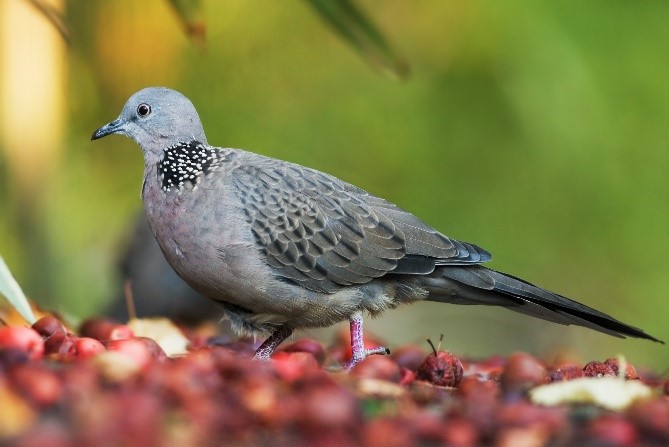
Eastern Spotted Dove, appearing blue-gray overall. (Austins Ferry, Tasmania, Australia; April 12, 2009.) © J.J. Harrison
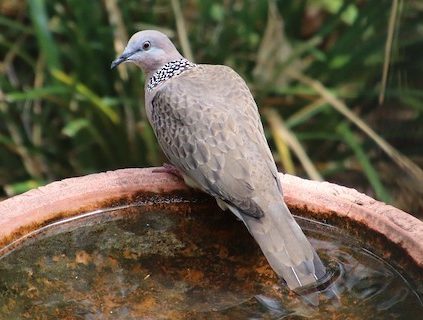
Eastern Spotted Dove. (Ironbark Place, Bridgeman Downs, Brisbane, Queensland, Australia; December 24, 2019.) © Lorix Bertling
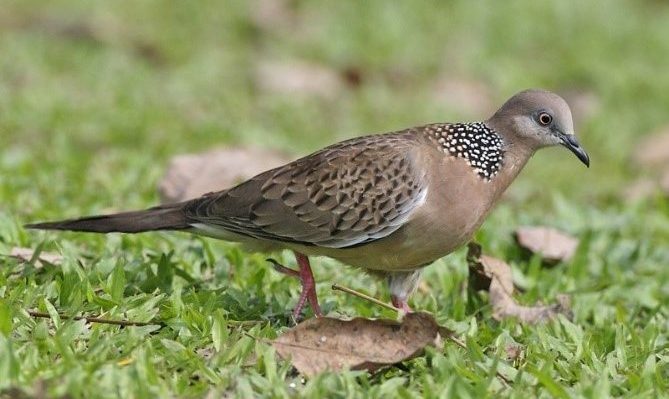
Eastern Spotted Dove, showing white leading edge on folded wing. (Singapore Botanical Gardens, Singapore; March 30, 2008.) © Lip Kee
The wings often show a broad whitish or pale-gray bar. At rest, the bar appears at the shoulder and leading edge of the folded wing. In flight, it shows as a perpendicular stripe.
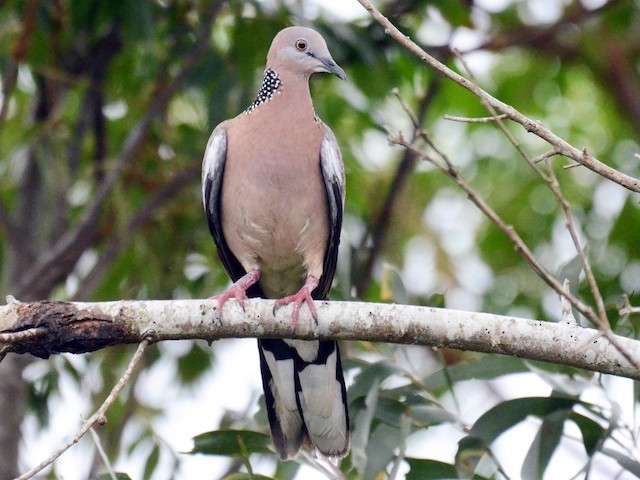
Eastern Spotted Dove, showing white leading edge on folded wings and mostly white undertail. (Eagleby, Logan, Queensland, Australia; October 16, 2017.) © Stephen Haase
The three outer tail feathers are broadly tipped with white and graduated in length. The undertail coverts are also white, so the undertail often appears mostly white when folded.
Viewed from above, the tail appears sandy-brown when folded, and shows white corners when spread.
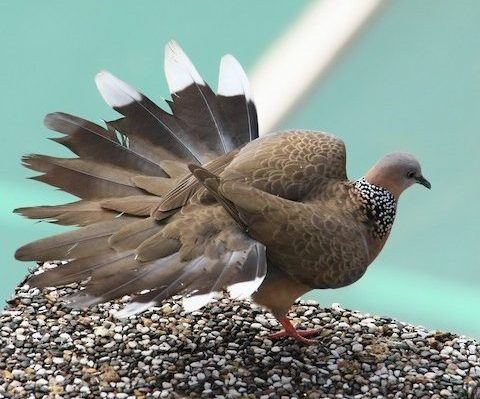
Eastern Spotted Dove, with tail fanned out, showing white tips on outer tail feathers. (Taipei, Taiwan; February 28, 2016.) © Poshien Chien

Eastern Spotted Dove, ventral view. (Heatherdale, Whitehorse, Victoria, Australia; August 17, 2019.) © Dan Forster

Eastern Spotted Dove, showing grayish bar on wing. (Royal Botanic Gardens, Melbourne, Victoria, Australia; October 27, 2019.) © Dan Forster
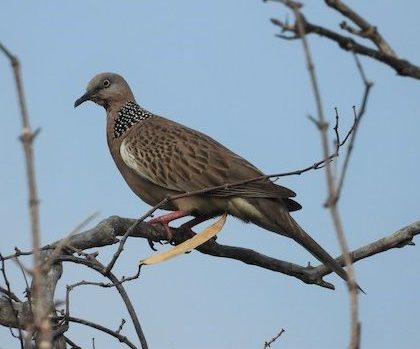
Eastern Spotted Dove, showing white leading edge on folded wing. (Bang Pu Recreation Center, Samut Prakan, Thailand; March 23, 2019.) © Ben Weil
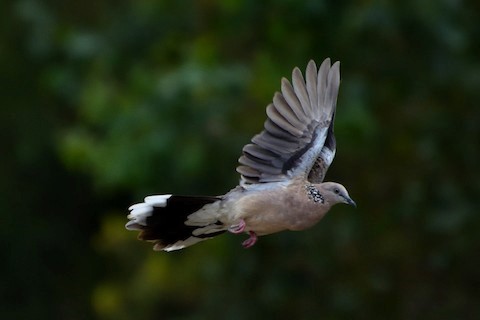
Eastern Spotted Dove, in flight, showing white tail corners and undertail coverts on mostly black tail—also note proportionately large tail. (Spring Farm, Camden, New South Wales, Australia; January 1, 2018.) © Anthony Katon
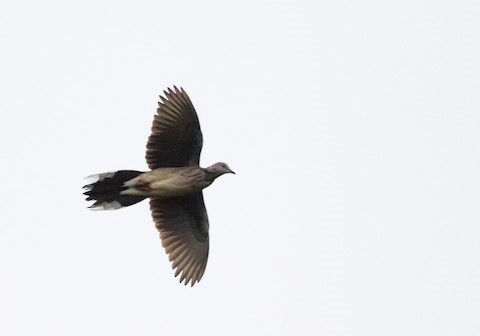
Eastern Spotted Dove, in flight, showing white tail corners and undertail coverts on mostly black tail. (Pak Chong, Nakhon Ratchasima, Thailand; October 13, 2019.) © Caleb Putnam

Eastern Spotted Dove, in flight, showing white tips on tail feathers and stripes on wings—also note proportionately large tail. (Jerrabomberra Wetlands, Canberra, Australia; December 10, 2016.) © shorty

Eastern Spotted Dove, preening and showing undertail coloration. (Nusa Dua, Bali, Indonesia; August 1, 2010.) © Lip Kee
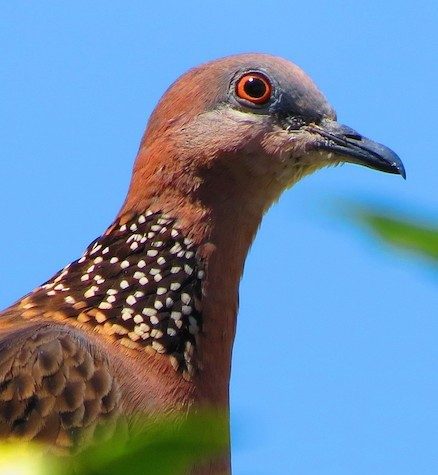
Eastern Spotted Dove, in full reddish flush, showing orange eye and gray orbital skin. (Campbelltown, New South Wales, Australia; October 31, 2012.) © Donna Nagiello
The orbital skin is gray (unlike the Western Spotted Dove, which has red orbital skin). The bill is black, and its color often extends back toward the eye as a blackish or dark gray line.
The eye usually appears yellow or orange, rarely red.
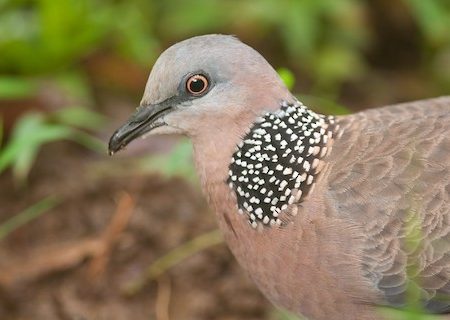
Eastern Spotted Dove, showing yellow iris and gray orbital skin. (Ho’omaluhia Botanical Garden, Honolulu, Hawaii; July 12, 2015.) © Etienne Artigau
Voice. A brief set of reverberating coos, usually four notes, along the lines of cu-CU-CUUUUU . . . KOOK!:
Cf. Western Spotted Dove. Western and Eastern Spotted Doves have traditionally been regarded as a single species, the Spotted Dove, and they are generally similar overall. The most consistent difference between them is the color of the orbital skin: red on Western versus gray on Eastern. Western’s eye also tends to be red, whereas Eastern’s is usually yellow or orange—but it can also be red. Without a close view of the face, it is still usually possible to distinguish Western from Eastern by the overall pattern of the wings and back, although both vary somewhat by age and season. The basic distinction is that Western appears comparatively dark with pale spots, whereas Eastern appears comparatively pale with dark spots. (This description simplifies more complex details, but summarizes the immediate visual impression.)
Notes
Polytypic species consisting of two recognized subspecies. Traditionally considered conspecific with Western Spotted Dove, collectively the Spotted Dove (S. chinensis), but there are consistent differences between the two and it seems increasingly clear that they are best regarded as separate species.
References
Baptista, L.F., P.W. Trail, H.M. Horblit, G.M., Kirwan, and E.F.J. Garcia. 2019. Eastern Spotted Dove (Spilopelia chinensis). In Handbook of the Birds of the World Alive (J. del Hoyo, A. Elliott, J. Sargatal, D.A. Christie, and E. de Juana, eds.). Lynx Edicions, Barcelona. https://www.hbw.com/node/54163. (Accessed December 26, 2019.)
BirdLife International. 2016. Spilopelia chinensis. The IUCN Red List of Threatened Species 2016: e.T60482887A95160992. http://dx.doi.org/10.2305/IUCN.UK.2016-3.RLTS.T60482887A95160992.en. (Accessed December 26, 2019.)
del Hoyo, J., N. Collar, G.M. Kirwan, and E.F.J. Garcia. 2019. Western Spotted Dove (Spilopelia suratensis). In Handbook of the Birds of the World Alive (J. del Hoyo, A. Elliott, J. Sargatal, D.A. Christie, and E. de Juana, eds.). Lynx Edicions, Barcelona. https://www.hbw.com/node/467132. (Accessed December 26, 2019.)
eBird. 2019. eBird: An online database of bird distribution and abundance. Cornell Lab of Ornithology, Ithaca, N.Y. http://www.ebird.org. (Accessed December 26, 2019.)
Gibbs, D., E. Barnes, and J. Cox. 2001. Pigeons and Doves: A Guide to the Pigeons and Doves of the World. Yale University Press, New Haven, Connecticut.
Hawaii Audubon Society. 2005. Hawaii’s Birds (Sixth Edition). Island Heritage Publishing, Waipahu, Hawaii.
Pratt, H.D., P.L. Bruner, and D.G. Berrett. 1987. A Field Guide to the Birds of Hawaii and the Tropical Pacific. Princeton University Press, Princeton, N.J.
Xeno-Canto. 2019. Spotted Dove – Spilopelia chinensis. https://www.xeno-canto.org/species/Spilopelia-chinensis. (Accessed December 26, 2019.)

